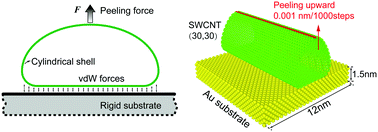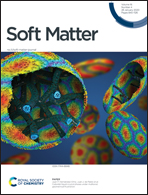The peeling behavior of compliant cylindrical shells in adhesive contact with a planar rigid substrate
Abstract
In this work, we study the peeling of a cylindrical shell attached to a smooth rigid substrate and subjected to a vertical force. A generalized peeling model based on the energy-variational approach is presented, and its numerical solutions characterize the cross-section profile and peeling force. The interfacial interactions are represented by the Lennard-Jones potential. Molecular dynamics simulations are performed for the peeling system with single-walled carbon nanotubes and gold substrates, and simulation results show good agreement with the theoretical predictions. We show that there are three stages (stable peeling stage, line-contact stage, and pull-off stage) in the entire peeling process. A spring-like behavior is observed in the stable peeling stage. With the peeling displacement increasing, the second stage has a marked feature of line contact and the peeling force arrives at a peak pull-off force. Furthermore, we show that the pull-off force strongly depends on the flexural stiffness of cylindrical shell and two Lennard-Jones parameters, but is independent of the initial radius of cylindrical shell. Our findings may help to reveal the interactions between thin-walled nanotubes and substrates.



 Please wait while we load your content...
Please wait while we load your content...